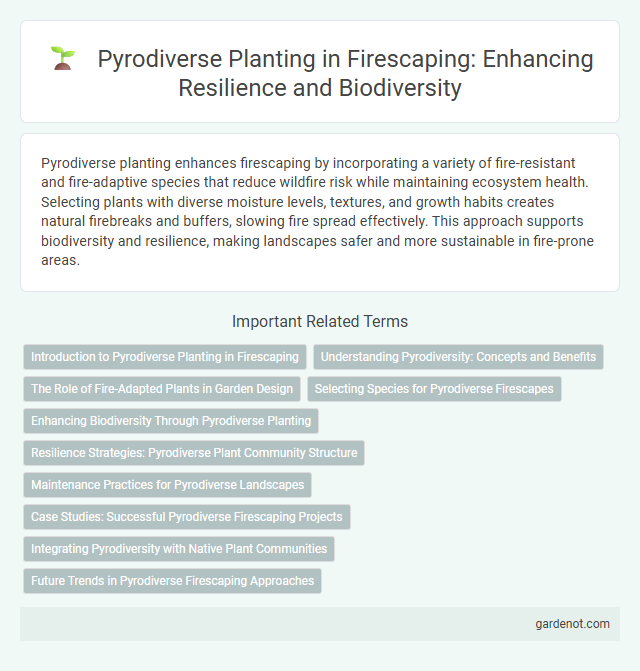Pyrodiverse planting enhances firescaping by incorporating a variety of fire-resistant and fire-adaptive species that reduce wildfire risk while maintaining ecosystem health. Selecting plants with diverse moisture levels, textures, and growth habits creates natural firebreaks and buffers, slowing fire spread effectively. This approach supports biodiversity and resilience, making landscapes safer and more sustainable in fire-prone areas.
Introduction to Pyrodiverse Planting in Firescaping
Pyrodiverse planting incorporates a variety of fire-adapted plant species to create resilient landscapes that reduce wildfire risk while supporting ecological health. These plants possess traits such as high moisture content, fire resistance, and natural fire breaks, which help slow fire spread and facilitate recovery post-fire. Implementing pyrodiverse vegetation in firescaping maximizes biodiversity and enhances landscape survivability against wildfires.
Understanding Pyrodiversity: Concepts and Benefits
Pyrodiverse planting integrates a variety of fire-adapted plants to enhance ecosystem resilience and biodiversity. Understanding pyrodiversity involves recognizing different fire regimes, such as frequency, intensity, and seasonality, which shape plant community structures and recovery processes. Implementing pyrodiverse landscapes reduces wildfire risks while supporting native wildlife habitats and promoting ecological balance.
The Role of Fire-Adapted Plants in Garden Design
Fire-adapted plants play a crucial role in firescaping by enhancing garden resilience and reducing wildfire risk through their natural ability to survive and regenerate after fire events. Species such as manzanita, ceanothus, and California fuchsia are drought-tolerant and possess thick bark or deep root systems that minimize fuel load and slow fire spread. Incorporating these pyrodiverse plants into garden design supports ecological balance while creating visually appealing landscapes that thrive in fire-prone environments.
Selecting Species for Pyrodiverse Firescapes
Selecting species for pyrodiverse firescapes involves prioritizing fire-resistant and fire-adapted plants that enhance ecosystem resilience and minimize wildfire spread. Native species with thick bark, high moisture content, and low volatile oils are ideal for reducing flammability while supporting biodiversity. Incorporating a diverse mix of shrubs, grasses, and trees creates a strategic landscape that disrupts fire continuity and promotes rapid post-fire recovery.
Enhancing Biodiversity Through Pyrodiverse Planting
Pyrodiverse planting enhances biodiversity by incorporating a variety of fire-adapted plant species that improve ecosystem resilience and habitat complexity. This approach supports native wildlife by providing diverse food sources and shelter, promoting a balanced and sustainable landscape. Fire-resilient vegetation reduces wildfire risks while maintaining ecological integrity in fire-prone regions.
Resilience Strategies: Pyrodiverse Plant Community Structure
Pyrodiverse planting enhances resilience by incorporating a variety of fire-adapted species with different life histories and flammability traits, creating a multi-layered plant community structure that disrupts fire spread. This strategy promotes ecosystem recovery through species that regenerate quickly after fire, maintain soil stability, and support biodiversity. Integrating shrubs, grasses, and trees with diverse phenologies ensures patches of vegetation burn at different intensities and times, reducing overall fire severity and promoting long-term landscape resilience.
Maintenance Practices for Pyrodiverse Landscapes
Maintenance practices for pyrodiverse landscapes emphasize strategic pruning, controlled irrigation, and regular removal of dead plant material to reduce fuel loads and promote fire-resistant growth. Integrating native, fire-adapted species like manzanita and ceanothus supports ecosystem resilience while minimizing invasive pests. Consistent monitoring and adaptive management ensure long-term fire risk reduction and biodiversity preservation in firescaped environments.
Case Studies: Successful Pyrodiverse Firescaping Projects
Case studies of pyrodiverse firescaping projects illustrate significant reductions in wildfire risk through strategic planting of fire-resistant species alongside native vegetation. Projects such as the Santa Monica Mountains Conservancy successfully integrated drought-tolerant chaparral and fire-adaptive grasses, enhancing ecosystem resilience while minimizing fuel loads. Data from these implementations demonstrate improved biodiversity, lower fire intensity, and faster post-fire recovery, making pyrodiverse planting an effective wildfire mitigation strategy.
Integrating Pyrodiversity with Native Plant Communities
Integrating pyrodiverse planting with native plant communities enhances ecosystem resilience by promoting varied fire-adaptive species that support natural fire regimes. Native plants adapted to local fire cycles improve biodiversity while reducing wildfire risk through strategic selection and placement. Pyrodiverse landscapes optimize fuel heterogeneity, aiding both ecological balance and effective fire management practices.
Future Trends in Pyrodiverse Firescaping Approaches
Future trends in pyrodiverse firescaping emphasize integrating native fire-resistant plant species to enhance ecosystem resilience and biodiversity. Advances in remote sensing technology and ecological modeling enable precise mapping of fire-prone areas, guiding strategic plant selection and landscape design. This approach promotes adaptive management practices that mitigate wildfire risk while supporting habitat restoration and carbon sequestration goals.
Pyrodiverse planting Infographic

 gardenot.com
gardenot.com